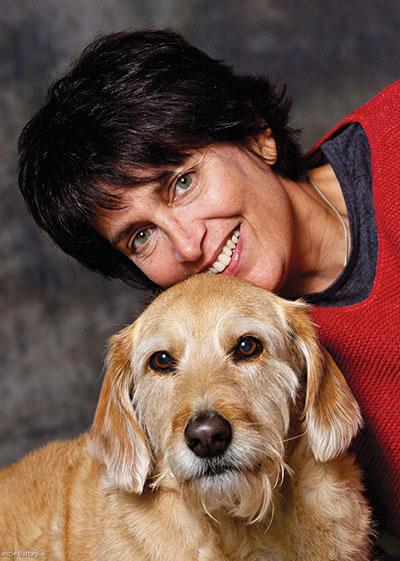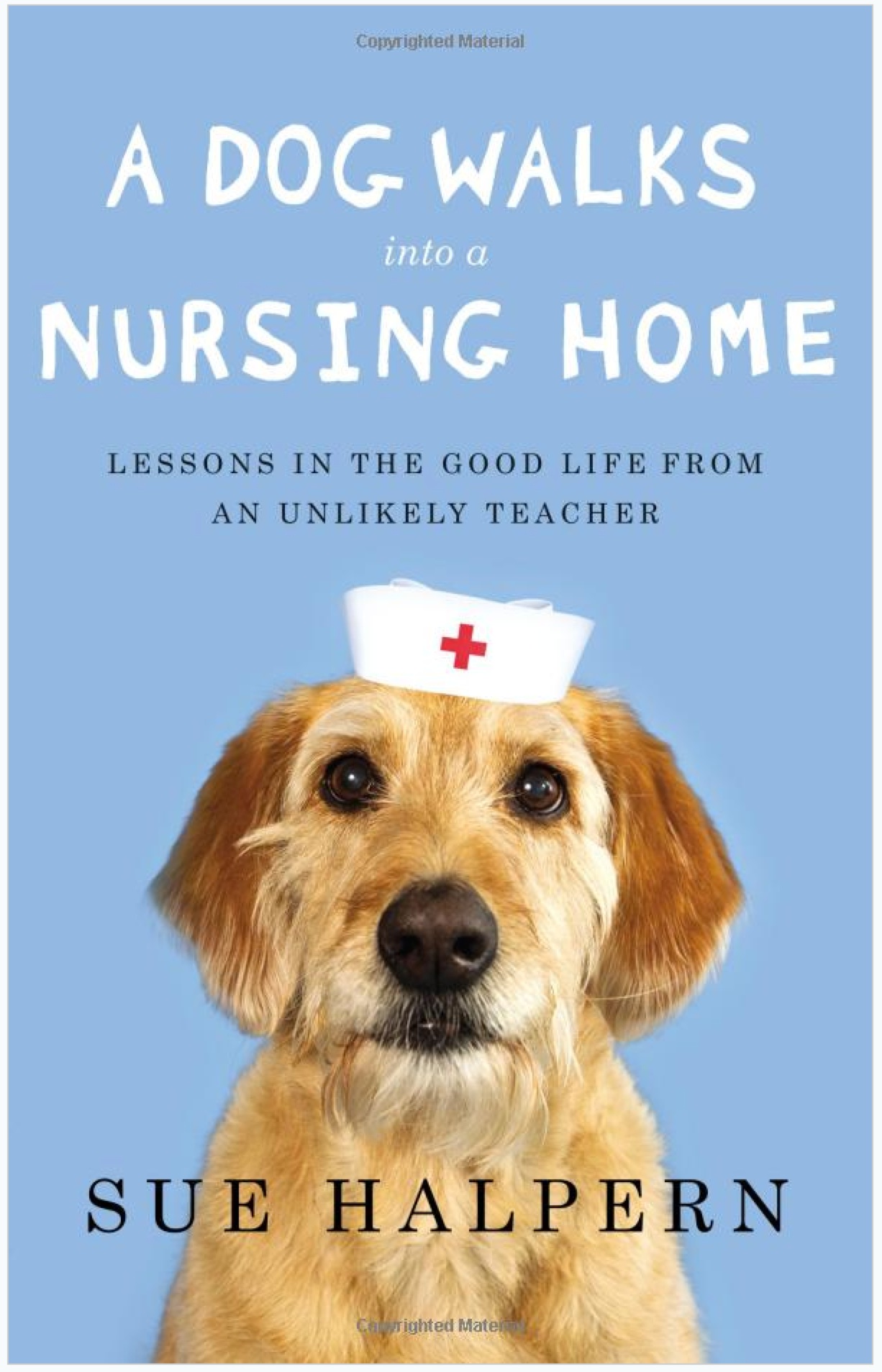Lessons in the Good Life from Pransky and Sue Halpern
by Sheryl Rapée-Adams
 |
A Dog Walks into a Nursing Home:
|
photo: Nancie Bataglia Pransky, with author Sue Halpern, went through the process of certification with Therapy Dogs International. |
|
Pransky is a Labrador-poodle mix that Vermont author Sue Halpern describes as "a wavy blonde with velvet ears" and eager eyes "below a pair of bushy eyebrows that [make] her look wise and professorial." The description is apt; Pransky is the teacher, as well as the star, of this story. In Halpern's newest book, A Dog Walks into a Nursing Home, she and her dog Pransky (named for Halpern's mother) train and get tested for certification through Therapy Dogs International (http://tdi-dog.org). The book then traces their Tuesday visits with the residents of a long-term care facility near her home that Halpern calls County. Interweaving skillful memoir and storytelling with expert research and reporting, Halpern brings County and its residents to life. Though her County could be anywhere, Halpern lives in Addison County and teaches at Middlebury College. Halpern and Pransky's first day at County, she describes her discomfort and lack of "basic knowledge of what to do and how to be." Halpern met Joe, who sitting in a wheelchair. Halpern looked into Joe's face to avoid staring where his legs had been amputated at the thighs. Pransky was fascinated with Joe's bandaged stumps, and a "mortified" Halpern wondered whether to call off her dog. Then Joe said, "Nice dog," and Halpern ended up enjoying the man's company while Joe petted Pransky and chatted about a dog he'd cared about. Halpern writes that she had been imagining her intact self in the man's place. Whereas Pransky met "people exactly where they were." Halpern writes, "A dog goes from 'hello' to 'I could really love you' in an instant, and means it." Wide Appeal While this book might appeal especially to animal lovers, any reader moved by the human condition will find plenty to dig into. Halpern's writing goes down so smoothly that before this reader know it, I had easily digested paragraphs and pages of Pransky's lively interactions with County residents, mixed with facts and statistics on healthcare (did you know that one in seven nursing home residents is under the age of 65?); the ethics of Aristotle; the philosophy of Schopenhauer; tenets of Buddhism; and poetry by Donne and Longfellow. The book's seven chapters are named for the ethical and theological virtues of Restraint, Prudence, Faith, Fortitude, Hope, Love, and Charity. Pransky demonstrates every virtue. Halpern delves into them all, with discourses and examples. Restraint is as mundane as a dog leash, and as significant as its Aristotelian notion of balancing good conduct against one's desires. Halpern, too, must exercise restraint; in small-town Vermont, she inevitably knows some of the County residents from their earlier lives, but must uphold confidentiality and discuss them with no one—not her neighbors who ask about them, not even other County residents. Prudence, in its definition as "practical wisdom" for Pranksy, means remaining calm, friendly, and compliant amid moaning people, moving wheelchairs, and clattering medical supplies. Of the virtue Faith, Halpern writes that she must have an aspirational faith in Pransky to do the right thing, to do their work at County right. Halpern delves into the big question of whether people's faith in the religious and spiritual increases as they move closer to death.
Life's Comedy The title A Dog Walks into a Nursing Home sounds like the beginning of a joke. Accordingly, the book is filled with humor. What could be more absurd, funny, moving, and cost-effective than an "air-conducting" musician-teacher who comes to County to lead "Conductorcise"? When Halpern first hears of Conductorcise, invented by former conductor and Metropolitan Opera Orchestra clarinetist David Dworkin, she is perplexed. "But after a year at County," writes Halpern, who watches some usually inert residents come alive, moving chopsticks to the rhythm of a Sousa march, "Conductorcise seemed like genius." Pransky had that effect on residents, too. Elders who had stopped speaking spoke to the gentle dog. People whose speech consisted mainly of complaints talked affectionately to Pransky, recounting tales of their own dogs and their lives on farms. Halpern found herself becoming more socially graceful with Pransky around; Pransky accepted people as they were – including Halpern. As Halpern was writing this book and discussing it with friends, she realized it was not about large issues like "moral philosophy and dogs" or "old people and dogs." Rather, she writes, the book is about one particular dog, Pransky. Good writing about the very particular seems to speak to the heart of the universal, saying something important to and about all of us. A Dog Walks into a Nursing Home does just that. Halpern discloses that she formerly taught medical ethics at a teaching hospital. She discusses nursing home residents' loss of autonomy and sometimes identity, the medicalization of aging and dying, the unequal distribution of care based on personal wealth, and the fact that about a third of the vast Medicare payouts to hospitals and doctors during the last two months of patients' lives have no meaningful benefit for patients. Subject or Object? Halpern's focus on ethics contrasts with her lack of attention to what I see as a central ethical issue in this book: the use of nonhuman beings in animal-assisted therapy. Animal-assisted therapy means "using animals in some way as therapeutic tools," write Dorothea Iannuzzi and Andrew N. Rowan in Anthrozoos: A Multidisciplinary Journal of The Interactions of People & Animals, (Vol.4, No. 3, "Ethical Issues in Animal-Assisted Therapy Programs"). To regard a living being as a tool is to overlook her needs and inclinations in service of her task and those she serves. Yet Halpern's love for Pransky obviously runs deeper than mere appreciation of a useful tool. So it's especially jarring when Halpern uses the pronoun "she" to describe Pransky, and "it" for other nonhuman animals. Mentioning another author's work, Halpern writes, "Grandin wrote about the necessity of holding a dog when it was a puppy and touching it all over…." In the book's acknowledgments, Halpern gives Pransky family-member status, thanking the "three house-McKibbens," listing Pransky first, followed by her husband Bill and daughter Sophie. Both Sophie and Bill have said that she "loved Pransky most of all, and then refuse[d] to say they were joking." Halpern writes that "Charles Darwin suggested that behaviors and attributes we like to think of as exclusively human are more likely to have been handed down from our animal ancestors. Increasing numbers of experts in varied scientific fields agree that nonhuman animals experience emotions and consciousness. Halpern undertook animal-assisted therapy to enrich Pransky's life when she was bored after Halpern's daughter left home for college. Since Pransky is unable to communicate in words, she relies on her humans to meet her needs as best they can. Halpern describes Pransky's exhaustion after, and sometimes during, nursing home visits. On the job, Pransky is "on" at all times, monitoring her surroundings, watching for Halpern's cues, doing what residents want her to do, and resisting her natural urges when they conflict with the rules, which Halpern calls "dense and hard and unrelenting." Pransky, who like other domesticated dogs wants to please her humans, "understood that it was part of her job to accommodate everyone's needs, whether the effect was pleasant or not." Iannuzzi's interviews and questionnaires with people involved in animal-assisted therapy programs found that "visitations should be limited to a maximum of one hour," and that "animals began to show signs of fatigue if visits continued for a longer period." Is being exhausted after a good day's work a bad thing? Pransky cannot tell Halpern, so it falls to Halpern to make decisions on Pransky's behalf. In It Together If Halpern took up the topic of the ethics of humans' ubiquitous utilization of nonhuman animals to fulfill humans' desires—based in a teleological ethics that the end justifies the means—surely she would dive deep and generate another work that would be hard to put down. As for Pransky, whatever ways nursing home work might have affected her, Pransky's presence was balm for the humans she met. Pransky sat with people who might never stand again. She lay beside residents who were dying, "doing the one thing she knew she could do, which was to provide the comfort of her body—its heft, its warmth, and its softness—at the moment when these women were most alone." Halpern writes, "After our bodies were done with us, what remained? If we were lucky, someone to tell our stories. So I will tell you about Fran and Lizzie and Dan and Thomas and the others Pransky and I met at County who are gone now…." Halpern demonstrates a few virtues herself. Halpern shows us that, as the saying goes, old age is not for the fainthearted, and neither is being a therapy dog. A Dog Walks into a Nursing Home left me eager to read Halpern's other works.
|
||
| Reviewer Sheryl Rapée-Adams, M.A., M.S., lives in Rutland with her spouse and three cats. She is a vegan, massage therapist, yoga teacher and nonprofit consultant, and volunteers on behalf of nonhuman and human beings. | ||

